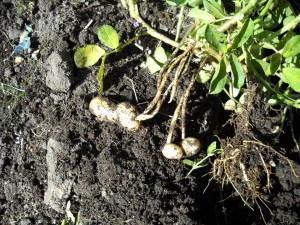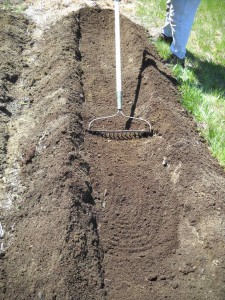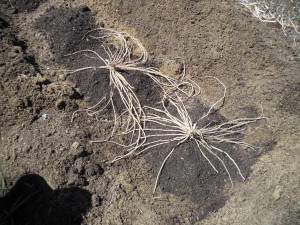My Vegetable Garden Report
Remember when we had to write reports about our summer vacations for school? Well, this is my report on my summer in the vegetable garden: what worked, what didn’t.
Overall, it was a great growing season. We had lots of sunshine and my garden got about an inch of rain a week, just what most plants need. My tomatoes suffered a bit from a variety of early blights – the leaves browned and dried up, starting at the bottom. This has been increasingly the case in recent years, and next year I intend to try a bio-fungicide called Serenade, which contains live bacteria that destroy fungi. Still, I put up lots of tomatoes and ate them 2 or 3 times a day from early August until the end of September.
Of the new varieties of tomatoes I tried this year I liked best a small red one called Mountain Magic, a full sized yellow called Valencia and an oversized plum tomato called Linguisa. The first two are from Johnny’s Seeds, the last from Hudson Valley Seed Library. All 3 were quite disease resistant.
At the end of September I saw what appeared to be the dreaded late blight so I sent a sample to the UNH plant pathology lab, and it was diagnosed as late blight. Fortunately, late blight does not survive our winters except, occasionally, in potato tubers.
What did well for me? It was a great year for onions, beets, carrots, broccoli and leaf crops from lettuce to kale. My most surprising success was my new asparagus patch. I planted roots in June, and each plant is now 6-12 bushy stems. Many of the plants sent up stems thicker than a pencil, but I restrained myself and did not eat any. I used a “Jersey” cultivar of asparagus which produces all-male plants and no seeds, which is good. Seeds yield too many little plants and these compete for water and nutrients. If you have older plants with seeds, cut them down now.
I always try a few new things in the garden if I can, and this year I got some peanuts for planting from Burpee Seeds. I planted some in cell-packs indoors since peanuts are a southern crop, and I wanted to give them an early start. I also tried direct planting once the soil was fully warmed in early July. Direct seeding didn’t work, and the transplants only produced a few peanuts each. Peanuts bloom down low, and then a “peg” develops
which contains the flower stem and peanut embryo. The peg grows into the soil, and produces a peanut. I only got 3 or 4 pegs per plant, so they are not worth the bother, I think.
I also tried scorzonera, a European root crop also called black oyster plant, serpent root, viper’s herb, viper’s grass and black salsify. I harvested one recently – but with some difficulty. I tried to pull it like a carrot, only to have the top break off. I used a trowel to loosen what I thought was pretty loose soil in my wood-sided raised bed. I got my hand down around the root some 6 inches below the surface and tugged. Slowly I lifted it out. Much to my surprise, the root was 12 inches long, black, and nearly perfectly cylindrical, though only ¾ of an inch across!
I also planted salsify, a similar root crop, though white. It is a slow-growing root crop. If you do try it, be advised that the young plants look like grass, so don’t weed them out. I enjoyed the flavor of both salsify and scorzonera, though I liked the latter better – it has a somewhat nutty flavor when sautéed in olive oil.
I planted purple cauliflower this summer, and it was very tasty. The variety I tried, from Franchi Sementi seeds promised that it would develop side shoots like broccoli, and I have seen a few little ones starting in October. The primary heads took until mid- to late-September to develop fully. Broccoli has been fabulous this year, producing side shoots into October. The variety that did best this year is ‘Arcadia’, and I will do it again next year. Very productive.
Usually I have no deer problems, but one rogue 4-point buck came around often. He ate my pole beans late in the season and several summer and winter squashes. Dang! I hope he doesn’t start a family here! My dogs aren’t keeping him away – I may have to reduce their dog biscuits quota to keep them on their toes.
Another new effort was growing ground cherries. These resemble tomatillos with paper skins, but with a sweet fruit inside. Very tasty, but they didn’t ripen until late September- if then. I learned they are called ground cherries because they fall on the ground when ripe.
Gardening is always somewhat a mystery. Sometimes one vegetable does well, other times it can be a complete bust. But I keep on experimenting with new things – that’s part of the fun of it.
Henry’s new book is out: Wobar and the Quest for the Magic Calumet from Bunker Hill Publishing. It is a chapter book for kids, a fantasy-adventure about a boy born with a mustache and a magical ability to speak to animals and understand them. Learn more at www.Gardening-Guy.com.
Putting The Garden To Bed
Just last week that I was planting tomato and pepper seedlings – or so it seems. But now the big yellow buses are out there each morning, delivering the next generation of gardeners to school, and there is a definite nip to the air when I go to get my newspaper out of the box in the morning. Where has the summer gone? It’s time to start thinking about putting the garden to bed.
This is the time of year that weeds take advantage of us. Most of us tend to be lackadaisical about weeds now that our vegetables have produced, our flowers have bloomed, and our attention has turned elsewhere (school, football, presidential debates). But if you want to reduce your work next year, pay attention to those weeds that have snuck into the garden: they are producing seeds that will lie in wait for the spring, ready to grow before we get the good plants established.
I hereby resolve to spend a minimum of 20 minutes every day weeding for the rest of September. If I do that, I shall save myself much aggravation next spring. Here are a few things to consider when you weed. First, weed when the soil is moist – you are much more likely to get out the entire root system. That is very important for perennials weeds like dandelions or witch grass because a scrap of their roots will regenerate new weeds.
Annual weeds pull more easily, and it’s less important to get the entire root. They reproduce by seed, and often produce hundreds, even thousands of seeds per plant – and those seeds can stay viable for years. When weeding things loaded with seeds, be careful not to shake off the seeds when you pull the weeds. It means that you can’t shake off all the topsoil that comes out with the roots, but I’d rather avoid dumping seeds into my garden soil- even if I lose some.
I also try to place seed-bearing weeds in a compost pile that I will not use any time soon. In fact, I have compost piles where I dumped problem weeds decades ago. I let it turn into soil and use it for fill dirt– but not in my vegetable garden. After all, I heard that King Tut’s tomb had weed seeds that were still able to germinate, though that may be just a myth.
I am also conscious of erosion when weeding and removing annual plants in the fall. I think it’s better to cut off the stem of big zinnias, for example, than yank them now. That way I am not opening up the soil, making it vulnerable to erosion or providing a nice resting spot for air-borne weed seeds. Many weed seeds are tiny and can blow in from your lazy next-door neighbor’s garden. I can always dig out roots in the spring when I plant something else, and they may decay and add some organic matter to the soil in the meantime.
In the vegetable garden it is important to get rid of diseased or insect-infested plants. You shouldn’t put them in the compost, either. Put them on the burn pile if you’ll be burning brush this winter, in the household trash, or in a pile far from the vegetable garden. This will help to minimize the recurrence of problems. That goes for moldy phlox or other flowers that get diseases, too.
If you have an asparagus patch, look to see if your plant are loaded with those little “berries”, their seeds. If you see seeds, cut down the stems before winter. Some of those seeds will settle in and start more asparagus plants, but you really don’t want more plants – they will fight for moisture and minerals just as weeds do. Most asparagus plants sold now are in the “Jersey” series and are all male, so they bloom but do not produce seeds. But one of the 25 plants I put in this year was a female, so take a look at yours now and cut down any with berries. And for best production, get out any weeds this fall.
I like to prepare my vegetable beds in the fall. After weeding them, I re-shape my mounded raised beds and add some compost or aged manure. Then I cover them with chopped fall leaves and grass that I rake up after mowing. This stuff does not blow away as you might imagine – one good rain storm and it settles down for a long winter’s nap.
Fall is a good time to spread some limestone on the lawn, or to your vegetable and flower gardens if your soil pH is acidic. Most things grow best at a relatively neutral pH, say 6.2 to 6.8, but what with acid rain, many of us have soil that is pretty acidic. This is a good time to get a soil test done and make adjustments as needed. It takes time to adjust soil pH, so working on that now will make the soil better next spring.
There is so much to do in the garden, week after week. It’s important not to just throw up your hands and say, “I’m done!” Yes, fall is here. But don’t stop gardening – everything you do now will help make next year’s garden even better.
Henry Homeyer is the author of four gardening books and a new children’s book just out called “Wobar and the Quest for the Magic Calumet”. Check for Wobar in your local bookstore or go online to henryhomeyer.com to learn more about the book.
Attention Lazy Gardeners: Asparagus is a (Nearly) Free Ride
As I am sure you know, once upon a time there were three little pigs. One built his house of bricks, one of sticks, and the lazy one built a house of straw. I forget the details, but I think the lazy one got eaten by the wolf – a moral for all kids and gardeners. Work hard, survive. But one exception to that rule is the asparagus patch. Each year you can have delicious food relatively work-free.
Okay, I exaggerate. There is considerable work in starting an asparagus patch, and a certain amount of work in keeping it weed-free. But it should come back reliably, year after year. So plant it well and keep it mulched to hold down weeds, and you can garner rewards year after year.
Twenty-five plants is a reasonable number of plants for a family of four, or for two people with my appetite for those sumptuous green spears. Asparagus needs rich soil with lots of nutrients, so have a good supply of compost or aged manure and some slow release organic fertilizer at planting time.
Get a soil test done before you plant, or get at least get a kit that will tell you the pH. Asparagus does best with a near neutral pH, in the range of 6.5 to 7.5. If your pH is less than 6.5 you will need to add limestone to “sweeten” the soil. The test kit will tell you how much limestone you need.
Before planting, dig out all weeds and especially grasses. Rototilling does not kill weeds and grasses, it just hides them. And they will come back to plague you for years. So weed well.
Because asparagus lasts for many years, it is important to enrich the soil more than you would for annual veggies like tomatoes or lettuce. In the old days –back when I was a kid – asparagus beds were dug deep, and manure was worked into the soil down to a depth of 18 inches. Asparagus roots were planted in a trench with the crown (where the roots originate) planted a foot deep and 18 inches apart.
Current thinking is that asparagus still needs good loose soil, but that the crown only need be planted 6 inches below the soil line. Using a hoe or shovel, create a trench 9 to 12 inches deep and 12 to 18 inches wide. Then loosen the soil in the bottom of the trench with a spading fork. Space rows 2 feet or more apart.
Plan on working in 4-6 inches of aged compost into the soil down at the depth where the roots will be, and in the soil you will use for backfilling the trench. Don’t skimp, even if you have good soil. Work the compost in with a spading fork or shovel. A rototiller would also do the job, but can adversely affect soil tilth or texture if done when the soil is too moist. And rototilling disturbs microorganisms and earthworms in the soil.
I also like to broadcast a generous dose of Pro-Gro or other slow-release organic fertilizer everywhere in the planting trench and mix it in. A quart yogurt container of organic fertilizer is fine for a dozen plants. Azomite, a mineral mix that provides micronutrients is a good additive, too. Green sand is an organic source of potassium and micronutrients from the sea. All of the above should be available at your local feed-and-grain store or garden center.
Asparagus roots are now sold that are all male – generally anything that has the word ‘Jersey’ in the name is all male (Is New Jersey a macho state?). ‘Martha Washington’ is the classic asparagus variety, but it has male and female plants, so they produce seeds – and little seedlings. This is not good. You don’t want extra seedlings growing in your patch, as they will compete with your plants for water and nutrients, just like weeds. Of course, you can pull the seedlings growing under Martha, and re-plant them elsewhere, but that sounds like work to me.
In the bottom of your trench build mounds of soil/compost mix. Drape the roots over the mounds with the crown sitting on top the mound. If the roots are longer than your trench is wide, swirl the roots around the mound a little. Then gently backfill your trench (or hole, if you did individual holes instead of a trench). Just an inch or two of soil is all that is required at the start. As the season progresses and the sprouts grow, add more soil/compost mix. By the end of the summer your plants should have 6 inches of soil over the crown.
A few recommendations: Have patience. Don’t pick any spears this year. Next year, just take one or two stalks per plant. Each year, take more – but never pick for more than 4 weeks. Taking too many spears will draw down their reserves and weaken the plants.
Keeping your asparagus patch well-weeded is important. Wood sides to an asparagus bed can help keep out creeping grasses, or you can dig a little moat around the bed to keep grasses from creeping in. Mulching with 6 pages of newspaper and 4 inches of straw will help keep down weeds and will hold in moisture.
Even if you are the quintessential third pig when it comes to gardening, don’t be lazy when planting asparagus. A little extra work now getting out weeds and working in healthy soil additives will pay you back many times over. Bon Appétit!
Henry Homeyer is a gardening consultant and author living in Cornish Flat, NH. His Web site is www.Gardening-guy.com.









